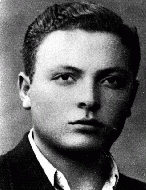
Joseph Gani
Born: 1926
Preveza, Greece
Joseph and his family lived in Preveza, a town with a Jewish population of 300 that was located on the Ionian seashore. Joseph's father had a small textile shop. The Ganis were of Romaniot descent, Jews whose ancestors had lived in Greece and the Balkans for more than a thousand years.
1933-39: Joseph attended Greek public school in Preveza. He also received a religious education; the local rabbi would come to the public school for several hours a week to give religious instruction to the Jewish students. Joseph loved sports, especially soccer and baseball.
1940-44: Germany invaded Greece in 1941 and took over the region where Preveza was located in the fall of 1943. The Jews of Preveza were deported to Auschwitz in Poland in March 1944. There, Joseph was assigned to work in Birkenau as part of the Sonderkommando, a work unit that carted corpses to the crematoria. On October 7, 1944, Sonderkommando workers in crematorium IV revolted, disarming SS guards and blowing up the crematorium. Soon, other Sonderkommando workers, including Joseph, joined in the uprising.
Joseph was killed in Birkenau in October 1944. He was 18 years old.